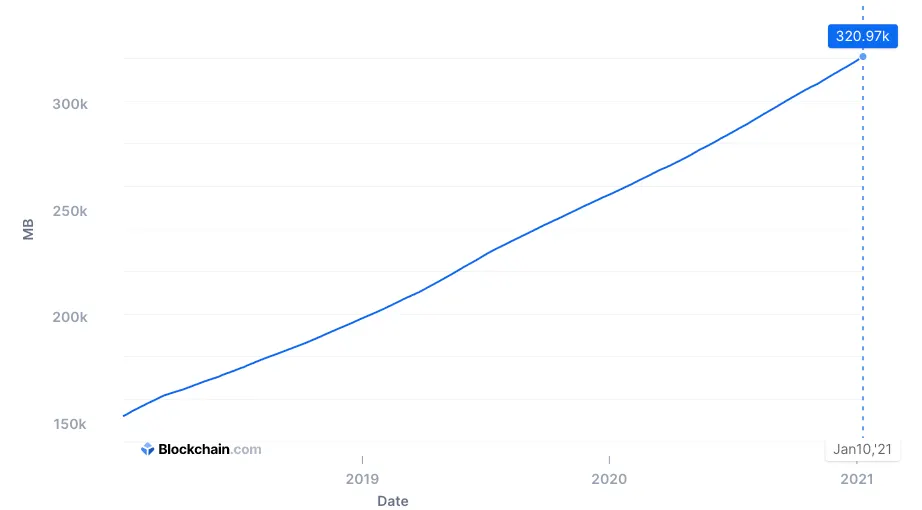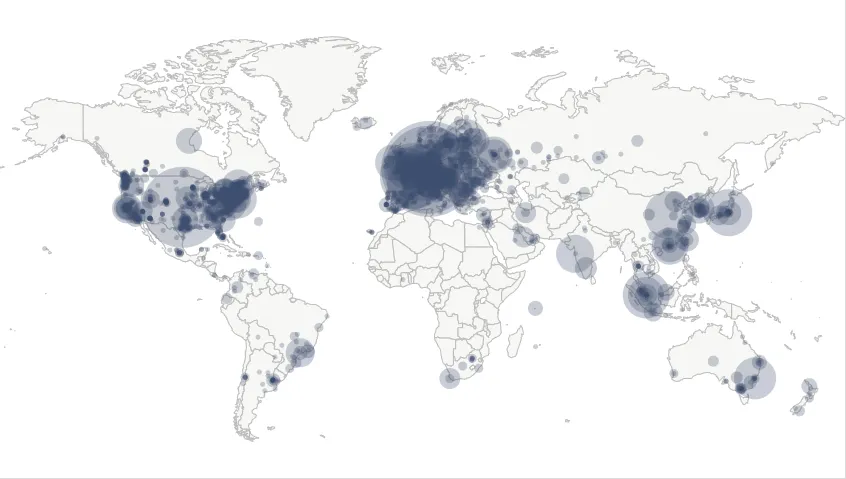In brief
- The Bitcoin blockchain currently weighs around 320 GB and is expanding at more than 50 GB per year.
- This can make running a full node a challenge, since many devices lack the necessary spare storage.
- A number of solutions to the issue are in the works, including Bitcoin light wallets and Utreexo.
In the decade-plus lifespan of Bitcoin (BTC), the cryptocurrency has seen considerable growth in several key areas—from adoption to utility, and value.
But it's also grown in another, less desirable way—its sheer size.
Like every database (decentralized or otherwise) the Bitcoin blockchain stores data. But unlike standard databases which often see older or unwanted data purged or deleted, the Bitcoin blockchain only gets larger over time, since it contains a complete record of all the transactions that ever occurred—including all the data they contain. Nothing ever gets deleted.
This has caused the Bitcoin blockchain to swell from just over 60 MB in January 2011 to over 320 GB ten years later in January 2021. The Bitcoin blockchain has now been growing at a linear rate for the past four years, adding an average of around 50 GB per year.
The Average Block Size is Increasing
There are a number of reasons why the Bitcoin blockchain is growing at such a staggering rate. For one thing, there are simply fewer empty blocks now.
Since the Bitcoin blockchain has been operating at almost maximum capacity for the last four years straight, most blocks are completely full—and there has been no major change in the maximum number of transactions the Bitcoin network can handle in the last two years.

Despite this, the average size of each block has been slowly increasing since Bitcoin first launched, climbing from 0.02 MB in January 2011, to 0.6 MB in January 2016, and finally to 1.3 MB in January 2021. This can be largely attributed to the increased adoption of Segregated Witness (SegWit), which allows for larger total block sizes, while keeping the size of each transaction down.
According to Woobull's SegWit Adoption chart, there has been a steady uptick in the use of Segwit transactions since the upgrade was activated in August 2017—and close to 50% of all transactions are now SegWit.
With increasing block size, the rate at which the size of the Bitcoin blockchain grows can also be expected to increase. At the current average block size of around 1.31 MB and 144 blocks mined per day on average, we can expect the Bitcoin blockchain to expand by up to 70 GB in the next year alone—sending it to almost 400 GB.

With most popular laptops and tablets still shipping with under 512 GB of storage space, it is becoming increasingly challenging for casual Bitcoin users to dedicate the space necessary to store the entire Bitcoin blockchain when running a full node. Likewise, with the cheapest consumer hard drives coming in at around $16/GB, those looking to run a full node will need to spend around $5.12 for the storage to do so in 2021.
Though this might be a simple task in many developed countries, it can limit the uptake of Bitcoin in developing economies, where the average income per household is much lower. This partially explains why more than 60% of Bitcoin nodes are concentrated in North America and Europe, while Africa and South Asia have just a small number of online nodes—despite their large populations.

Potential Solutions
More nodes contribute to a faster, healthier, and more censorship-resistant Bitcoin network, while decentralization is one of the core tenets of blockchain-based cryptocurrencies. Fortunately, there are a number of potential solutions in the works, which could help to make running a full node more accessible.
Overall, the cost of hard drives decreased from a minimum of $0.025/GB in 2017, down to as little as $0.15/GB in 2020—a decrease of 40% in 3 years. If this rate of decline continues, then by 2022 hard drives will get cheaper faster than the Bitcoin blockchain grows in size—thereby making it more economical to host a full node over time.
But there are also a number of technical solutions to the problem, which act to reduce the size of the storage burden on full nodes. One of the most common workarounds is known as a light node. These are essentially nodes that use a method known as Simplified Payment Verification (SPV) to verify transactions instead. These only need to download a small fraction of the blockchain, but do need to rely on a third-party full node that hosts the entire blockchain.
Another promising solution is Utreexo—a scaling solution currently being developed by Lightning creator Tadge Dryja. According to a July 2020 Medium post by the developer, Utreexo acts to make Bitcoin nodes smaller and faster by using cryptography to condense the information nodes need to store. Unlike a standard light wallet, this system doesn't rely on an external full node to host the full blockchain and also maintains the user’s privacy like a normal full node.
However, Utrexxo is still very much in its early stages of development, and is currently only available to use as a demonstration release. It will likely be several months, if not years before it is ready for mainstream use.
Bitcoin's blockchain will keep on expanding—that's the nature of blockchains. But if these technical solutions work, and they can be implemented, blockchain bloat may no longer present the barrier to Bitcoin's growth that it currently does.

